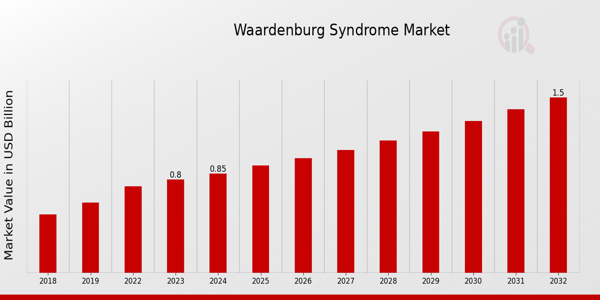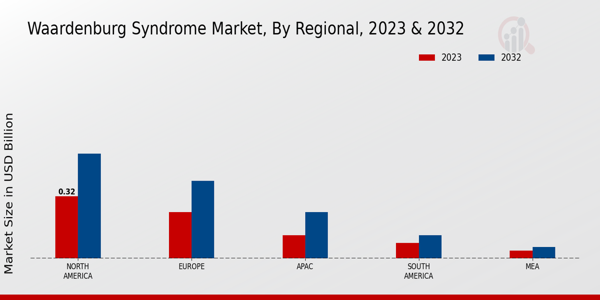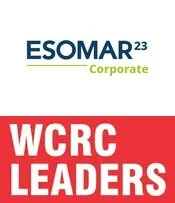Waardenburg Syndrome Market Overview
As per MRFR analysis, the Waardenburg Syndrome Market Size was estimated at 0.91 (USD Billion) in 2024. The Waardenburg Syndrome Market Industry is expected to grow from 0.98 (USD Billion) in 2025 to 1.85 (USD Billion) till 2034, at a CAGR (growth rate) is expected to be around 7.32% during the forecast period (2025 - 2034).
Key Waardenburg Syndrome Market Trends Highlighted
The Waardenburg Syndrome Market is surging in light of specific trends that have emerged due to a growing public awareness of the existence of genetic illnesses and improved methods of diagnosis. The continuous efforts by various healthcare organizations to raise awareness amongst practitioners and the community about rare genetic disorders foster better prognosis and management of Waardenburg Syndrome. Also, an upsurge in the number of research activities directed towards genetic therapies is fuelling this market, as patients require management of their conditions. There are several opportunities present in the market, especially in terms of personalized medicine, which is created for a specific pattern of genes belonging to an individual.
With the evolution of the basic concept of technology, there is a possibility of developing more advanced therapeutic methods that can cure genetic disorders, Waardenburg Syndrome inclusive. Furthermore, increasing coverage of healthcare in developing countries creates opportunities for the market, as more patients are able to receive diagnosis and treatment. Recent changes in the market demonstrate the growing trend of integrated care, which incorporates genetic counseling as an essential component of a multifaceted treatment approach. Ongoing deficits in access to genetic specialists and supportive services for families of the patients, are alleviated by the modern telehealth technologies. Last but certainly not least, AI is now being applied in genetic studies and this will greatly improve predictive modeling, leading to important breakthroughs in the understanding of the complex nature of the syndrome.
The growing emphasis on patient-centered care is drawing the need for support systems for patients suffering from Waardenburg Syndrome. All in all, these trends signify a high growth potential and improvement in the clinical outcome of the markets concerning Waardenburg Syndrome around the world.
Source: Primary Research, Secondary Research, MRFR Database and Analyst Review
Waardenburg Syndrome Market Drivers
Increasing Awareness and Diagnosis of Waardenburg Syndrome
One of the primary drivers of the Waardenburg Syndrome Market Industry is the increasing awareness and diagnosis of Waardenburg Syndrome among healthcare professionals and the general public. As understanding improves, more individuals are being diagnosed with the condition, which is a genetic disorder characterized by pigmentary abnormalities and sensorineural hearing loss. The rise in public awareness campaigns and educational programs by various health organizations has led to a greater understanding of the symptoms, implications, and management of this syndrome.Furthermore, advancements in genetic testing, along with the reduction in costs associated with these tests, allow for better identification of patients with Waardenburg Syndrome. This trend not only enhances diagnosis rates but also drives the demand for specialized treatments and management options, thereby propelling growth in the market. In addition, the increase in the number of healthcare providers adopting the latest tools and technologies to diagnose and manage this condition is creating a favorable environment for the Waardenburg Syndrome Market Industry.As more genetic counselors and specialists enter the field, the potential for reaching undiagnosed patients increases, which will further contribute to market expansion.
Growth in Genetic Research and Therapeutic Developments
The Waardenburg Syndrome Market Industry is strongly propelled by the ongoing growth in genetic research and therapeutic developments. Increased funding from both government and private sectors into genetic research has opened new avenues for understanding the various mutations that cause this syndrome. As scientists continue to explore the genetic underpinnings of Waardenburg Syndrome, there is a growing potential for developing tailored therapies and interventions which will contribute to improved patient outcomes.Furthermore, enhanced collaboration between research institutions, universities, and pharmaceutical companies is fostering an innovative landscape where new treatments and potential cures can thrive, consequently boosting market growth.
Rising Incidence of Genetic Disorders
Another significant driver for the Waardenburg Syndrome Market Industry is the rising incidence of genetic disorders globally. As genetic disorders, including Waardenburg Syndrome, become more prevalent due to various factors, such as increased environmental exposures and lifestyle choices, the need for targeted treatments and diagnostic tools grows correspondingly. Public health initiatives aimed at understanding the prevalence and implications of these disorders have gained momentum, contributing to an increased focus on healthcare solutions tailored to genetic conditions.This shift in public health perspectives enhances the demand for treatment options, making it a crucial market driver.
Waardenburg Syndrome Market Segment Insights
Waardenburg Syndrome Market Type Insights
The Waardenburg Syndrome Market is experiencing a noteworthy trajectory, particularly within the Type segment, which is critical to understanding this rare genetic disorder. As of 2023, the overall market is valued at 0.8 USD Billion, and it is projected to grow significantly over the next few years. Within the Type segment, Type 1 holds a majority share, valued at 0.25 USD Billion in 2023, with expectations to rise to 0.45 USD Billion by 2032. This prominence can be attributed to the higher prevalence rates of Type 1 compared to other types, making it a focal point for treatment developments and research initiatives.In the current landscape, Type 2, valued at 0.22 USD Billion in 2023 and expected to increase to 0.4 USD Billion by 2032, reflects a growing recognition of its manifestations and treatment options. This type follows closely behind Type 1, indicating a significant interest from both healthcare providers and pharmaceutical companies looking to address the requirements of patients affected by this variant. Conversely, Type 3 commands a valuation of 0.18 USD Billion in 2023, expected to enhance to 0.3 USD Billion by 2032, showcasing a unique position within the market due to its distinctive characteristics. This type presents challenges for diagnosis and awareness, which can lead to decreased research funding, yet the increasing clinical focus is gradually paving the way for advancements in treatment options.Lastly, Type 4 is valued at 0.15 USD Billion in 2023, projected to grow to 0.25 USD Billion by 2032. This type remains the least dominant within the Waardenburg Syndrome Market, possibly due to its rarity and the complexities associated with its symptoms. Nevertheless, the incremental growth reflects an opportunity for researchers and healthcare professionals to develop specialized interventions that can significantly improve the quality of life for individuals impacted by Type 4.Overall, the Waardenburg Syndrome Market segmentation highlights the interdependence of each type, underlining the potential for innovative treatment pathways and collaborative efforts among industry stakeholders. This burgeoning market provides ample room for further investigation and advancements, driven by demographic shifts and a better understanding of the genetic factors underpinning Waardenburg Syndrome. As healthcare providers and researchers increasingly focus on tailored approaches for each type, the market growth is set to follow suit, with substantial opportunities arising in the coming years. The ongoing exploration into the Waardenburg Syndrome Market data reaffirms the vital nature of understanding these segments, not only to address patient needs but also to cater to the evolving landscape of genetic disorders.

Source: Primary Research, Secondary Research, MRFR Database and Analyst Review
Waardenburg Syndrome Market Diagnosis Method Insights
The Waardenburg Syndrome Market, valued at 0.8 Billion USD in 2023, emphasizes the significance of various diagnosis methods, which are crucial for accurate identification and management of the syndrome. The market is characterized by a blend of clinical examination, genetic testing, and imaging techniques that collectively enhance patient care. Clinical examinations play a vital role in the preliminary assessment, allowing healthcare providers to gather essential information through physical evaluation. Genetic testing is becoming increasingly significant, providing definitive confirmation of the syndrome through the identification of specific genetic mutations.Imaging techniques further strengthen the diagnostic process by assisting in visual assessments that can reveal associated anatomical anomalies. Together, these methods represent a comprehensive approach to diagnosis and understanding of Waardenburg Syndrome. As the Waardenburg Syndrome Market continues to evolve and grow, advancements in these diagnostic methods are expected to improve accuracy and efficiency, thereby contributing to better patient outcomes. The integration of innovative technologies within these methodologies is likely to drive further advancements in the understanding and management of Waardenburg Syndrome.Insights drawn from the Waardenburg Syndrome Market data reflect a steady market growth trajectory fueled by these critical diagnostic capabilities.
Waardenburg Syndrome Market Treatment Type Insights
The Waardenburg Syndrome Market, particularly in the Treatment Type segment, is witnessing significant growth driven by an increasing understanding of the disorder and its management options. In 2023, the overall market was valued at 0.8 Billion. The market's segmentation reveals that various treatment approaches like Surgical Intervention, Therapy, Medications, and Supportive Care play pivotal roles in comprehensive patient management. Surgical Intervention is critical for addressing physical manifestations and achieving better aesthetic outcomes, while Therapy addresses the psychosocial aspects of the syndrome, enhancing overall quality of life.Medications contribute significantly by managing symptoms effectively, while Supportive Care ensures patients receive holistic support tailored to their needs. This multifaceted approach is essential, given the complexity of the syndrome, as it helps address both physical and emotional challenges faced by patients. The market's growth can be attributed to improved patient awareness, advancements in treatment methodologies, and a growing emphasis on personalized care. As the industry evolves, focusing on these key treatment types will likely further enhance patient outcomes and overall market growth.Associations, increased funding, and research into Waardenburg syndrome treatments also present opportunities for innovation and market expansion.
Waardenburg Syndrome Market End User Insights
The Waardenburg Syndrome Market revenue, valued at 0.8 USD Billion in 2023, demonstrates a strong interest in the End User segment, which comprises Hospitals, Specialty Clinics, and Research Institutions. Hospitals play a crucial role due to their capacity to provide a vast range of medical services and specialized care for patients with Waardenburg Syndrome, making them a dominant force in the market. Specialty Clinics are significant as they offer tailored treatments and insights specifically for genetic disorders, thus fostering advancements in patient management and care.Research Institutions contribute to market growth by focusing on innovative solutions and treatments, crucially influencing the development of effective therapies for this syndrome. The diverse capabilities of these End Users align with the needs of patients, thereby solidifying their importance and contribution to the overall market dynamics.
Waardenburg Syndrome Market Regional Insights
The Waardenburg Syndrome Market is expected to be valued at 0.8 USD Billion in 2023 and shows growth prospects across various regions. North America leads with a valuation of 0.32 USD Billion, accounting for the majority holding in the market due to advanced healthcare infrastructure and increased awareness of genetic disorders. Europe follows with a valuation of 0.24 USD Billion, benefiting from strong research initiatives and a comprehensive healthcare system. The APAC region, valued at 0.12 USD Billion, is gaining traction as rising healthcare investments and increasing disease awareness contribute to its growth potential.South America, with a valuation of 0.08 USD Billion, and MEA at 0.04 USD Billion, reflect emerging markets with modest growth driven by healthcare improvements and increasing recognition of rare genetic conditions. The overall Waardenburg Syndrome Market statistics signify a growing focus on genetic disorders, presenting opportunities for market expansion across these regions while also facing challenges such as varying levels of healthcare access and funding.

Source: Primary Research, Secondary Research, MRFR Database and Analyst Review
Waardenburg Syndrome Market Key Players and Competitive Insights
The Waardenburg Syndrome Market is characterized by a unique set of challenges and opportunities due to the rarity of the syndrome, which affects pigmentation and hearing. Market players are focusing on innovation, advanced research, and strategic collaborations to enhance their product lines targeted toward the management and treatment of Waardenburg Syndrome. The competitive landscape showcases companies striving to enhance their therapeutic offerings, enhance patient quality of life, and expand their market reach. As a result, the demand for specialized healthcare services and targeted therapies is on the rise, forcing companies to continuously adapt and optimize their strategies to meet the evolving needs of patients and healthcare providers. Sanofi has established a significant presence in the Waardenburg Syndrome Market through its commitment to research and development. The company boasts a robust portfolio of therapeutic solutions aimed at addressing the symptoms associated with Waardenburg Syndrome. Sanofi's key strength lies in its extensive experience in the pharmaceutical sector, coupled with significant investments in innovations that enhance patient health outcomes. Its advanced clinical trials and partnerships with healthcare institutions allow it to stay ahead competitively by offering targeted treatments and patient-centric services. Furthermore, Sanofi's global footprint provides it with a unique advantage ing reaching diverse patient populations, facilitating a broader understanding and management of Waardenburg Syndrome across different demographics.Merck is another vital player in the Waardenburg Syndrome Market, known for its strong focus on research and strategic initiatives aimed at rare genetic disorders. The company leverages its extensive expertise and innovative capabilities to develop effective therapeutic strategies tailored specifically for conditions like Waardenburg Syndrome. Merck’s emphasis on scientific research allows it to unveil progressive treatments that resonate with healthcare providers and patients alike, ensuring a steady demand for its pharmaceuticals. Additionally, the company’s robust distribution network and strong relationships with healthcare professionals position it favorably within the market. By prioritizing transparency and collaboration, Merck enhances its reputation and trust among stakeholders, thereby solidifying its position in the competitive landscape of Waardenburg Syndrome management.
Key Companies in the Waardenburg Syndrome Market Include
- Sanofi
- Merck
- Johnson and Johnson
- Teva Pharmaceutical Industries
- Gilead Sciences
- Novartis
- AstraZeneca
- Amgen
- Biogen
- BristolMyers Squibb
- UCB
- Vertex Pharmaceuticals
- Roche
- Pfizer
- Regeneron Pharmaceuticals
Waardenburg Syndrome Market Industry Developments
Recent developments in the Waardenburg Syndrome Market have shown significant activity, particularly regarding advancements in treatment options and increased research funding. Companies such as Sanofi and Merck are focusing on innovative therapies targeting the genetic underpinnings of the syndrome, which has garnered attention from investors and researchers alike. The market is experiencing robust growth as public and private sectors are investing in genetic research and patient support initiatives. Additionally, AstraZeneca and Gilead Sciences are exploring partnerships to develop potential therapies aimed at addressing the symptoms associated with Waardenburg Syndrome. In terms of mergers and acquisitions, notable organizations like Johnson & Johnson and Biogen have recently expanded their portfolios through strategic acquisitions aimed at enhancing their research capabilities in rare genetic disorders. The overall market valuation is on the rise, driven by increased awareness, innovations in genetic therapies, and a growing focus on rare diseases, creating a dynamic environment for stakeholders within the industry. Companies such as Vertex Pharmaceuticals and Roche are also making significant contributions to expanding the therapeutic landscape for Waardenburg Syndrome, aligning with evolving patient care strategies and market demands.
Waardenburg Syndrome Market Segmentation Insights
- Waardenburg Syndrome Market Type Outlook
- Type 1
- Type 2
- Type 3
- Type 4
- Waardenburg Syndrome Market Diagnosis Method Outlook
- Clinical Examination
- Genetic Testing
- Imaging Techniques
- Waardenburg Syndrome Market Treatment Type Outlook
- Surgical Intervention
- Therapy
- Medications
- Supportive Care
- Waardenburg Syndrome Market End User Outlook
- Hospitals
- Specialty Clinics
- Research Institutions
- Waardenburg Syndrome Market Regional Outlook
- North America
- Europe
- South America
- Asia Pacific
- Middle East and Africa
-
-
-
-
-
- Beta
Beta feature
Beta feature
Beta feature
| Report Attribute/Metric |
Details |
|
Market Size 2024
|
0.91 (USD Billion)
|
|
Market Size 2025
|
0.98 (USD Billion)
|
|
Market Size 2034
|
1.85 (USD Billion)
|
|
Compound Annual Growth Rate (CAGR)
|
7.32 % (2025 - 2034)
|
|
Report Coverage
|
Revenue Forecast, Competitive Landscape, Growth Factors, and Trends
|
|
Base Year
|
2024
|
|
Market Forecast Period
|
2025 - 2034
|
|
Historical Data
|
2020 - 2024
|
| Market Forecast Units |
USD Billion |
| Key Companies Profiled |
Sanofi, Merck, Johnson and Johnson, Teva Pharmaceutical Industries, Gilead Sciences, Novartis, AstraZeneca, Amgen, Biogen, BristolMyers Squibb, UCB, Vertex Pharmaceuticals, Roche, Pfizer, Regeneron Pharmaceuticals |
| Segments Covered |
Type, Diagnosis Method, Treatment Type, End User, Regional |
| Key Market Opportunities |
Increasing genetic testing demand, Growing awareness programs, Advancements in targeted therapies, Enhanced diagnostic technologies, Expansion in patient support services |
| Key Market Dynamics |
increasing genetic testing demand, rising awareness of disorders, advancements in treatment options, growing prevalence of Waardenburg Syndrome, supportive government initiatives |
| Countries Covered |
North America, Europe, APAC, South America, MEA |
Frequently Asked Questions (FAQ) :
The Waardenburg Syndrome Market is expected to reach a value of 1.5 USD Billion by 2034.
The CAGR for the Waardenburg Syndrome Market is anticipated to be 7.3% from 2025 to 2034.
The North American market is expected to be valued at 0.54 USD Billion in 2032, driving significant growth in the overall market.
The market size for Type 1 Waardenburg Syndrome is projected to be 0.45 USD Billion in 2034.
Major players in the Waardenburg Syndrome Market include Sanofi, Merck, Johnson and Johnson, and Gilead Sciences.
The market for Type 2 Waardenburg Syndrome is expected to reach 0.4 USD Billion by 2034.
The APAC market for Waardenburg Syndrome is projected to grow to 0.24 USD Billion by 2032.
Type 3 Waardenburg Syndrome is expected to have a market size of 0.3 USD Billion in 2034.
The South American market is expected to grow to 0.12 USD Billion by 2032.
The market for Type 4 Waardenburg Syndrome is anticipated to be valued at 0.25 USD Billion in 2034.















